The Lake Issue
The Lake Vanishes
A dirty dance of hubris and geology
Most people don’t know Mountain Lake, Virginia, and if they do, it’s probably from a 1987 movie they caught on cable TV. The little blue jewel of the Blue Ridge Mountains stars in one of the most iconic scenes from Dirty Dancing – the one where Johnny Castle (played by a hunky Patrick Swayze) catches and lifts a panting, teenage Baby (Jennifer Grey) above lush rolling hills and crystal-clear water.
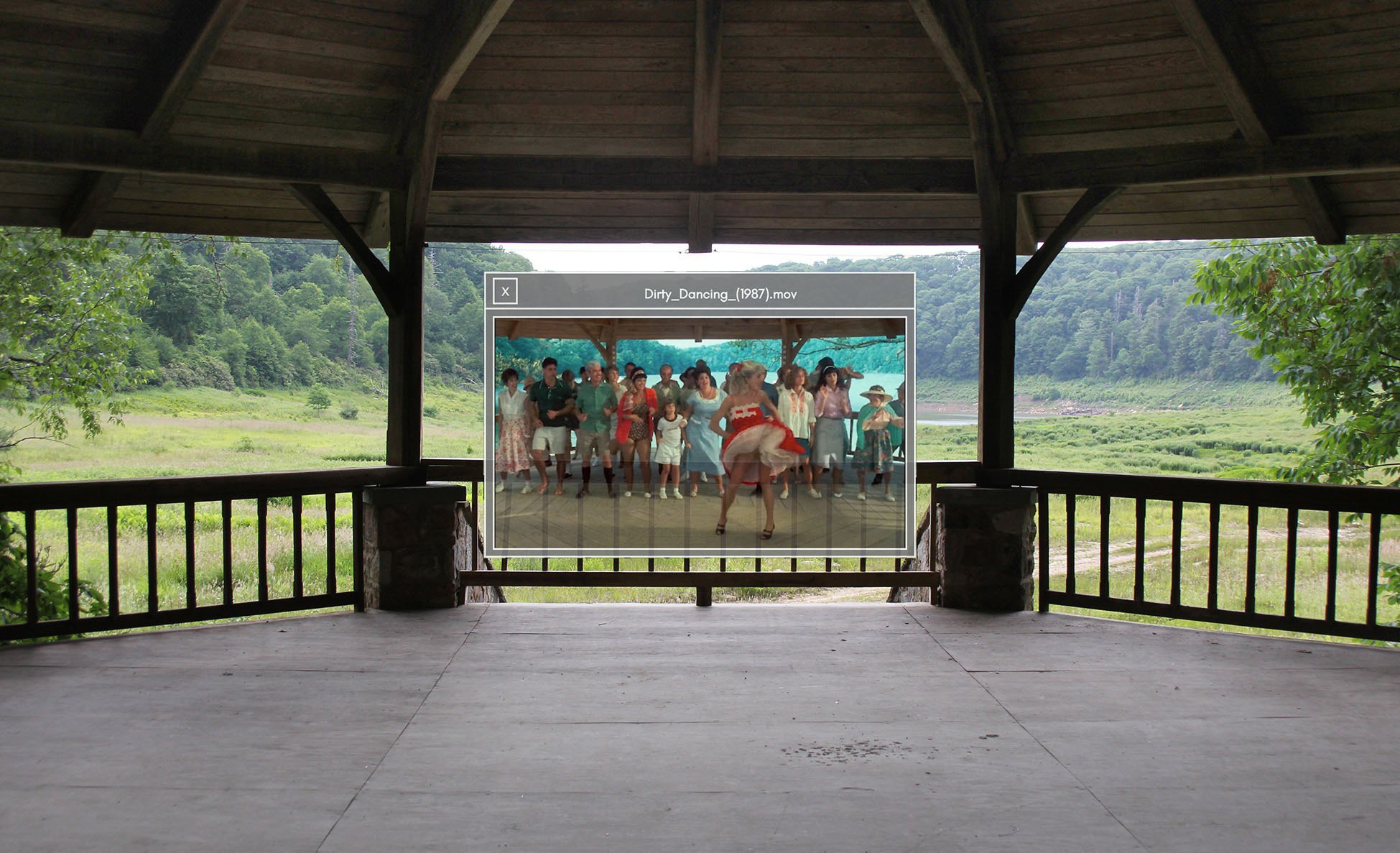
Nearly three decades after the iconic movie first hit box offices, devoted fans are still sneaking snapshots of Baby’s cabin, conga-ing at lakeside gazebos and pouring over ‘hidden mysteries’ of the film. And they’re traveling to places like Mountain Lake in pop culture pilgrimages, to re-live the scenes – over and over and over again.
The water vanished without a trace.
There is one mystery, however, that threatens the pursuit of their Dirty Dancing fantasies. In 2008, the same year Patrick Swayze was diagnosed with fatal, stage IV pancreatic cancer — the water at Mountain Lake vanished without a trace.
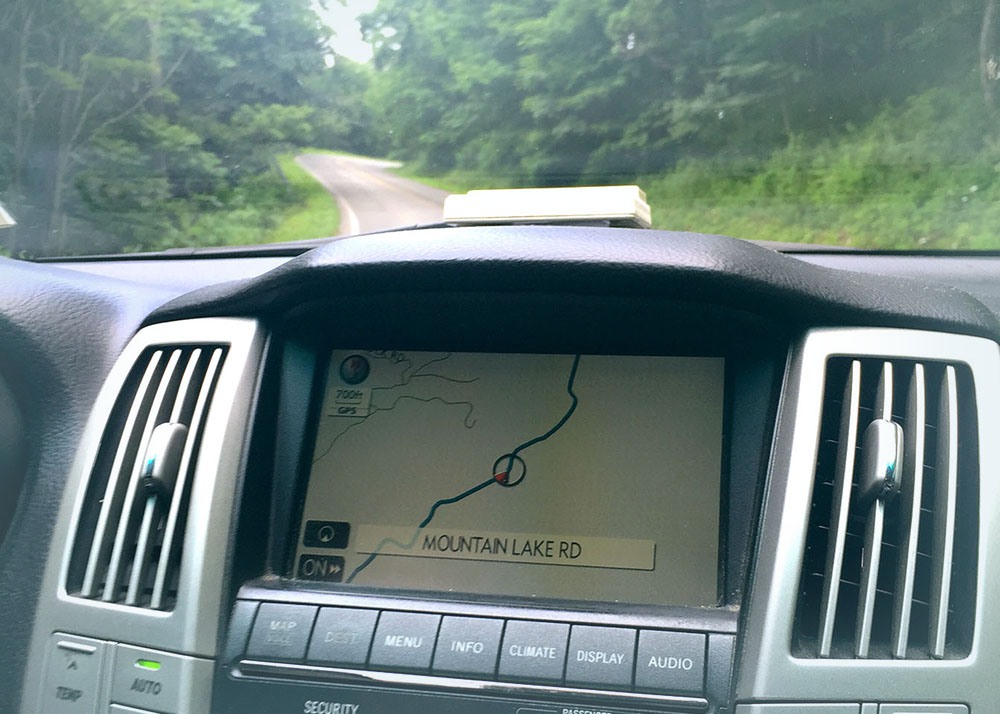
June 30th 2015. Blacksburg, Virginia. It’s the kind of place where most of the kids you talk to have jobs like “woodfire pizza cook,” “movie theater projectionist,” "persian rug salesman" and “kombucha brewer.” Lots of folks volunteer at the local organic farm. People actually know your name.
Most locals tell us Mountain Lake is just a place “somewhere up in the mountains,” “where all the tourists go,” or somewhere their “friend used to work over the summer.” We heard something about great hiking and a geologic controversy, decided to make the trip.
It’s a seven-mile, twisty-turny, two-lane road up to the resort. Late June, 3pm, 88 degrees, which folks tell us is about as hot as it’s going to get up in the Blue Ridge mountains. The road slowly deteriorates into patches and potholes the closer you get to Mountain Lake.
Suddenly, through a break in the trees, there’s chipped paint on tawny rooftops, a cracked blue tennis court with puddles forming on the left-hand sideline. A massive, human-size chess set on the lawn. Some listless (serene?) looking hotel guests – mostly families clad in khakis, polos and light blue florals. We park our car in gravel and head toward where we think the lake might be. Can’t see much over waist-high grass.
An Aquatic Anomaly
Film fans will tell you: Although Dirty Dancing was supposedly set in New York’s Catskill Mountains, the real-world backdrop is nestled near the ridges of “Salt Pond Mountain” up in Giles County, VA, near the border of West Virginia. The hotel and lake themselves sit just North of Blacksburg right off the Appalachian Trail, in one of America’s last-remaining wildernesses. Mountain Lake is the only naturally-formed lake in the Southern Appalachian range.
Geologists will tell you: There is no lake in the entire world that is like Mountain Lake. Field researchers still don’t fully understand its origins, unique cyclicity, or what’s going on beneath the lake’s surface. Because of this, the site has become a sort of mystery mecca for Earth science as well, with researchers dipping their toes in Mountain Lake long before – and after – Dirty Dancing was ever filmed there.
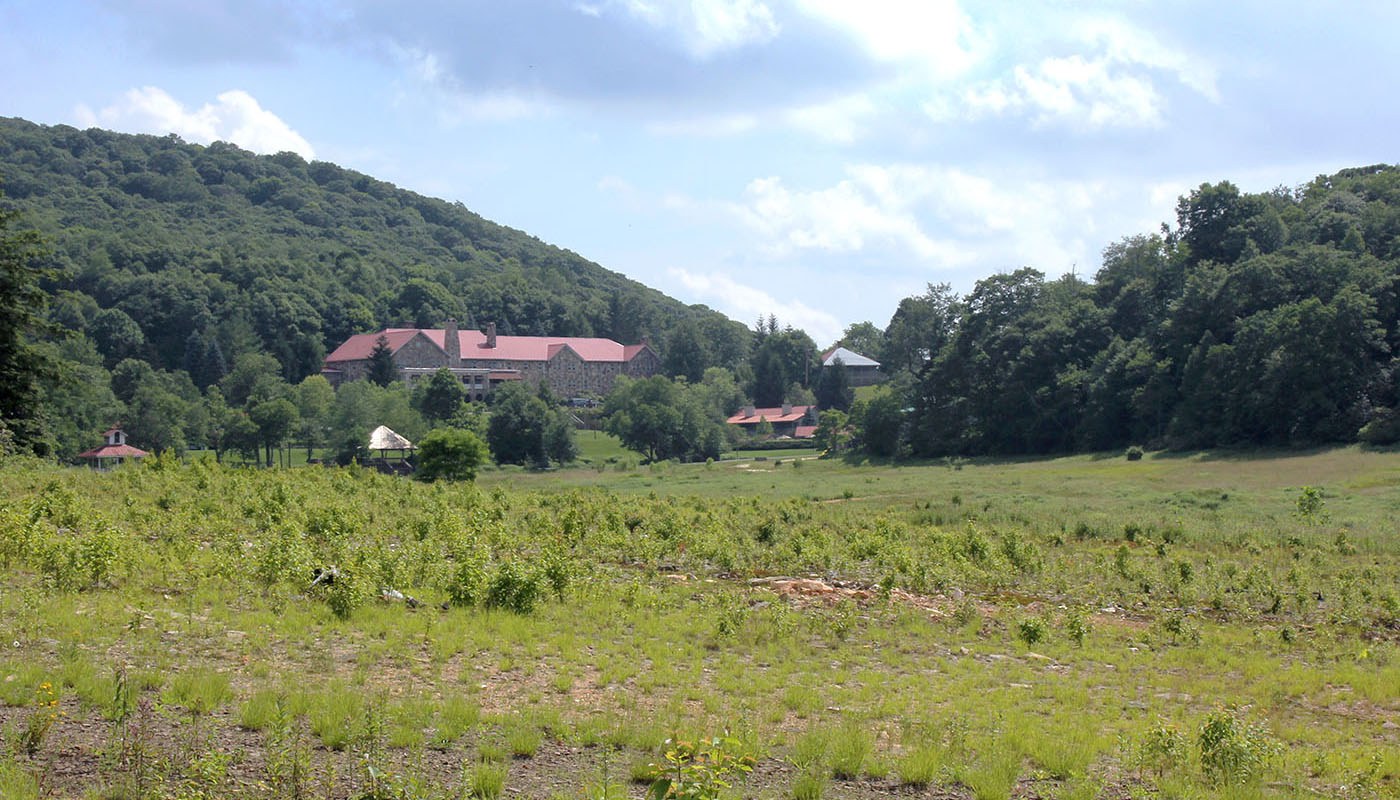
Then there’s the Lodge. In the 1850’s a wooden hotel was originally built on Mountain Lake as a scenic stopover for stagecoaches making their way out West. By 1930, the property was bought cheap in the midst of the Great Depression by a Texas insurance and banking tycoon named William Lewis Moody, who tore down the old lodge and built an elite “pleasure resort” out of giant stones sourced straight from the surrounding Blue Ridge Mountains.
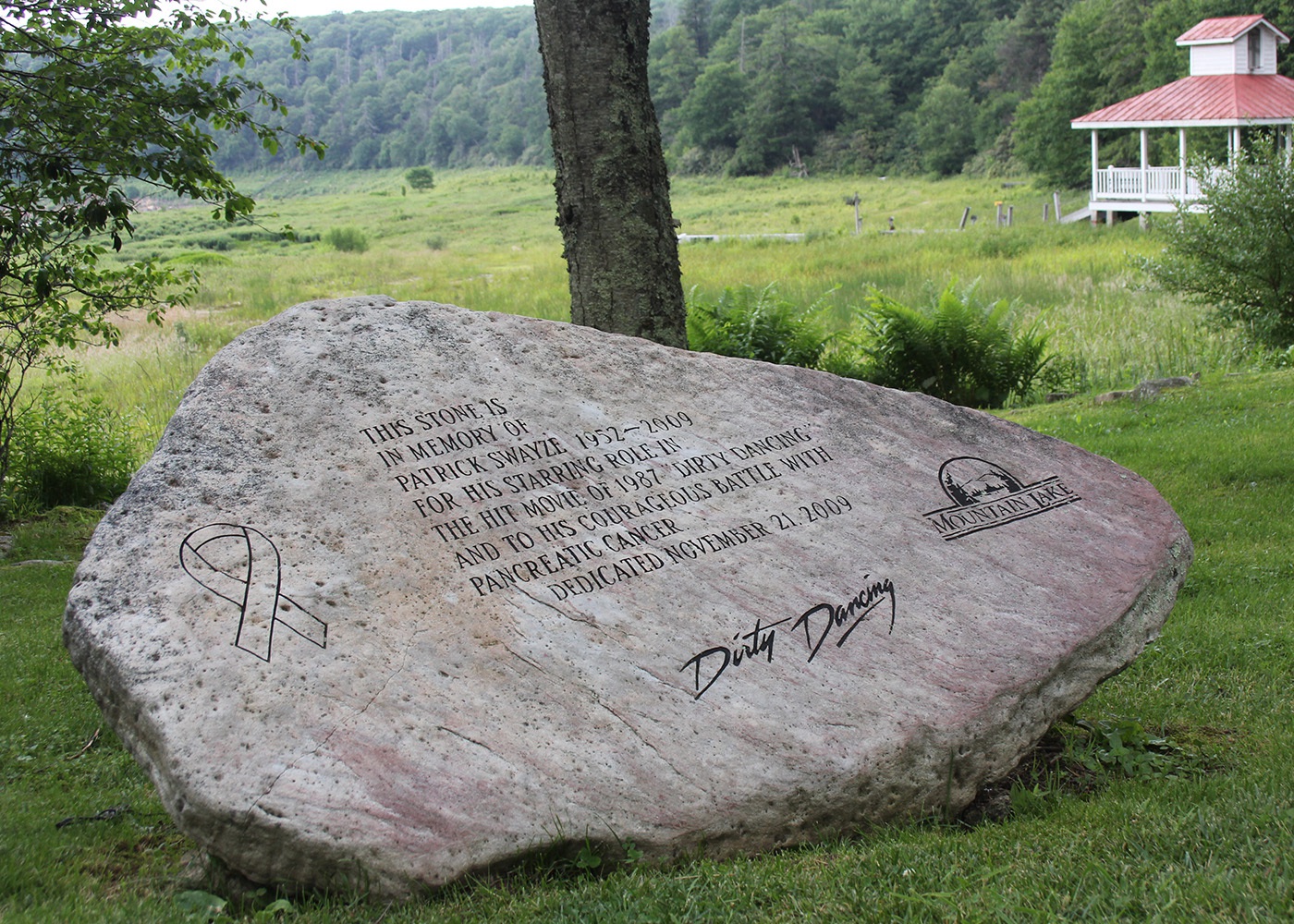
The millionaire’s daughter, Mary Moody Northern, inherited the estate from her father after he died, and ran the place until her death in 1986, the same year Dirty Dancing was filmed there. By the early 2000’s the hotel was still up and running, Mountain Lake was full and glistening, and no-one was expecting what mother nature had in store.
1751, LAKE LEVEL – 80%
Christopher Gist, a colonial British explorer becomes the first European to "discover" Mountain Lake, putting it into written record. Gist originally names the body of water “Salt Pond.” Settlers by the name of Lybrook move in to inhabit the nearby New River Valley, where the body of "pristine blue water" is located atop a scenic mountain-top basin.
“We still have very little idea where the water is going,” says Dr. Jon Cawley, Associate Professor of environmental studies at Roanoke College in nearby Salem, VA. The biologist/geologist, our expert for this report, has been researching Mountain Lake for more than 20 years.
Water surveys show the lake started draining in 2005, but folks outside of the science world didn’t really notice until around 2006. By then, the freshwater reservoir was already down to about half its normal level. The water kept draining until 2008, when for three days, the lake went completely dry—leaving piles of rotted fish, a human skeleton and columns of thick, soupy mud behind on its basin.
And there were holes. Lots of holes. Five large ones and 15 smaller ones, not to mention constellations of tiny pores, all down in the lake’s deepest section. Today, the theories of where the water of the film-famous lake has disappeared have become nearly as numerous as Mountain Lake’s mysterious drains.
Going down there and sinking up to your knees in mud, you could actually see these holes with the naked eye. They were inch to 12-inch size holes, with water pouring right down into them. Jessica Zielske, Mountain Lake Conservancy
“We used to think it was somewhat straightforward,” says Dr. Cawley, when asked for his theories on where the lake’s water is headed. Until 2008, the majority of geologists involved at the site theorized that Mountain Lake’s drainage water simply ended up in Pond Drain, the largest stream pouring out of Mountain Lake, which starts at the lake’s Northwest corner and eventually flows into the Cascade waterfalls some miles further down the mountain.
“However, there was a group of students some seasons ago that put dye into the hole at the bottom of the lake when it was essentially empty,” says Dr. Cawley. “So far, it’s been inconclusive.” In other words, no matter how hard they looked, researchers couldn’t find any significant dye deposits in any of Mountain Lake’s surrounding streams.
As for alternative theories, some researchers point to Virginia’s karst landscape and the possibility of limestone caves or reservoirs beneath the lake. Others suggest evidence of old fault lines located at the bottom, adding an element of seismic surprise to the geology. Many more researchers are eyeing a complex sedimentary bedding that lines the lake’s bottom, which seems to shift and sink, open and close, according to a natural system not entirely understood by the human world.
Since the 1960s, researchers have thrown remote-controlled submersibles, sonar equipment and even scuba divers deep into the abyss, trying to learn its secrets. They’ve done seismic mapping, electric resistivity tests and flow monitoring studies, searching the lake bed while it’s been both empty and full of water. Yet no-one has come up with any conclusive evidence yet about where the lake’s water drained.
We were bleeding money. Honestly, we were even talking about the long-term plan for the foundation. Mountain Lake Executive Director Betty Massey
Q/A
Betty Massey is the executive director of the Mary Moody Northern Endowment: a Galveston, Texas-based foundation that funds and oversees Mountain Lake Lodge. Here, she speaks to Silica about what happened to the hotel during those first years without a lake, and what their plans are, moving forward, to sustain the hotel’s business.
Silica
So the Mountain Lake Resort is owned by a Texas-based foundation and run by a volunteer board of directors. That’s super-strange for a hotel business model. How did that get set up?
Betty Massey
Well, when Mary Moody Northern died in 1986 at the age of 93, she never had kids and her husband preceded her in death. Aside from some personal bequests, she left the bulk of her estate, almost everything – real estate, personal property, the family home in Galveston and Mountain Lake – to this foundation she set up in 1968.
Silica
So the Mountain Lake Resort is owned by a Texas-based foundation and run by a volunteer board of directors. That’s super-strange for a hotel business model. How did that get set up?
Betty Massey
Well, when Mary Moody Northern died in 1986 at the age of 93, she never had kids and her husband preceded her in death. Aside from some personal bequests, she left the bulk of her estate, almost everything – real estate, personal property, the family home in Galveston and Mountain Lake – to this foundation she set up in 1968.
Mrs. Northern left that foundation with three responsibilities: One, was to keep running Mountain Lake. Two, was to establish a museum in her home in Galveston, and three, was to continue her charitable work. We do that primarily in the Galveston area.
Wasn’t there a will that Mary Moody Northern left when she died, saying that Mountain Lake had to be maintained without “upsetting the delicate ecology of the beautiful surrounding land?”
Yes. One of the guiding principles in our long-term development plan was that there had been enough man-made buildings and construction done in the basin of the lake, and we weren’t going to do any more. Other than that, there was nothing – no sort of document you could look at and say, “This is our guidance” from Mrs. Northern.
Still, in the spring of last year, the board of directors finished a conservation plan, which addresses everything from the water on the property to the recreation done on it. But we’re not a legal conservancy. Just a 2,600 acre place with a conservation plan.
Has it been tough maintaining the Mountain Lake Resort since the lake disappeared?
So, in 2008, the lake goes dry. At the same time, we are sitting in Galveston, having just experienced a 22-foot storm surge covering our island from Hurricane Ike. Every piece of property we own, both personal and business-wise has experienced some kind of damage. I mean, I lost my house to Ike.
So we’ve got the lake gone dry, business drops significantly and we started having to think long-term, basically asking “What are we going to do about Mountain Lake?” We were bleeding money. Honestly, we were even talking about the long-term plan for the foundation.
After a year of deliberation, in 2011, we decided to hire the Urban Land Institute out of Washington, D.C. and gave them a pretty open question about the land in Virginia – ”What do we do?” And they basically gave us three choices: One, you can keep managing decline, keep writing the checks until the money runs out. Two, you can close it, call it a day and walk away. Or three, you can do a fruit basket upset – Change the way you manage it, the way you govern it, the way you brand it. And that’s in fact, what we decided to do.
Part of that re-brand involved trying to fill in the holes in the bottom of Mountain Lake to bring it back, right?
That was something we thought long and hard about. It a was respectful process, simply accelerating what the natural progression for refilling the lake would be. In a very crude and unsophisticated way of explaining what we did, we took indigenous rock and soil and stuffed it in the holes. We didn’t mine it. We tried to use the material that was there, and just get it down into those holes.
Did it work?
I would say it was done with mixed success. Obviously, we don’t have a lake.
So, what now?
So we have this name, Mountain Lake – and it’s kind of hard when you don’t have a lake. But making the conservation plan kind of made us realize that this place isn’t only about the lake you saw in Dirty Dancing. It’s about the forest, and the wildlife that is there, the plants, the coldwater streams and the trails, the views.
Does the Mary Moody Northern endowment plan on supporting the Mountain Lake property for the forseeable future?
Hehe, I hope so. It’s ours!
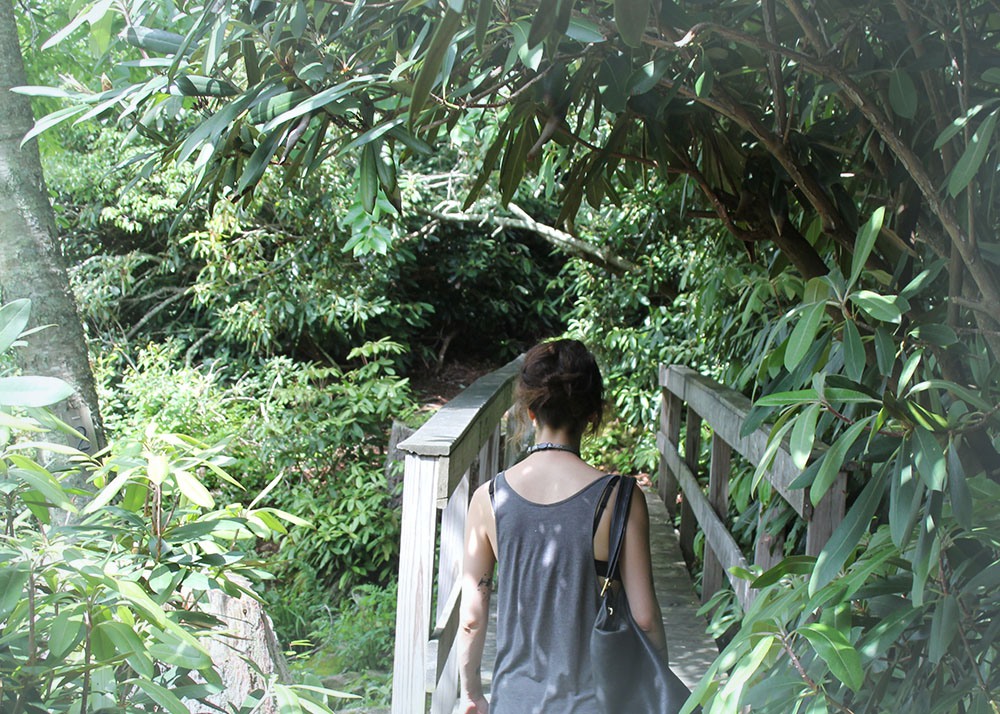
We pass a paint-chipped gazebo we recognize from the scenes of Dirty Dancing. Next to it, overlooking some grass is the hotel’s Patrick Swayze memorial rock, stuck in the mud there sometime after his death in 2009. It is now surrounded by festering weeds. Decide to take the “Indian Trail” through the woods to the right of what we think used to be a lake.
The path is moss-strewn, lined by 100-year-old rhododendrons, their branches surrounding the path in a sort of leafy skeleton. We trip on gnarled, knotted roots. Weather-worn signs denoting the land’s ecology look like they haven’t been changed out for at least a few seasons.
It’s a seven-mile, twisty-turny, two-lane road up to the resort. Late June, 3pm, 88 degrees, which folks tell us is about as hot as it’s going to get up in the Blue Ridge mountains. The road slowly deteriorates into patches and potholes the closer you get to Mountain Lake.
And then we see it. Peering out over a meadow, on a narrow bridge that crosses over a crystal-clear spring, we spot the lake. It’s brown and blue and roughly the shape of the ‘fried crawdads’ we ate for dinner at a pub the night before. The lakebed is completely abandoned. We’re the only ones there. After crossing the bridge, we approach a pile of loose rocks, where we decide to make our descent into the basin.
Many of the recent studies conducted at Mountain Lake haven’t been simply for the sake of geologic research, either. There was a business to run. And that first year without water, hotel occupancy dropped nearly 50 percent.
Even though researchers still don’t know where Mountain Lake’s drains lead, they have known for years that the illustrious water was due to run dry eventually. Back in 1999, when Dr. Jon Cawley was just a PhD student at Virginia Tech mapping out the bottom of Mountain Lake for his doctoral thesis, he made a pretty foreboding prediction for the disappearing lake, long before hotel profits or Dirty Dancing super-fans would even think about the effects.
To paraphrase parts of the study, Dr. Cawley had scuba divers plunge down into the icy cold water to map out the lake bottom and take sediment core analyses that would later be used in dating the lake. What they discovered, through these samples, was that the basin was at least 6,000 years old. They also inferred that at least six prolonged periods of lakebed dryness had occurred at the site in the past— 100, 400, 900, 1200, 1800 and 4100 years ago.
Nearly a decade before the lake ran dry, Dr. Cawley and his team were also already in the midst of mapping out a complex system of drainage holes, as well as the six small input streams that work to re-stock the lake’s water. Of particular interest was one major input stream, running mostly underground along a linear fault-like feature (more on that later).
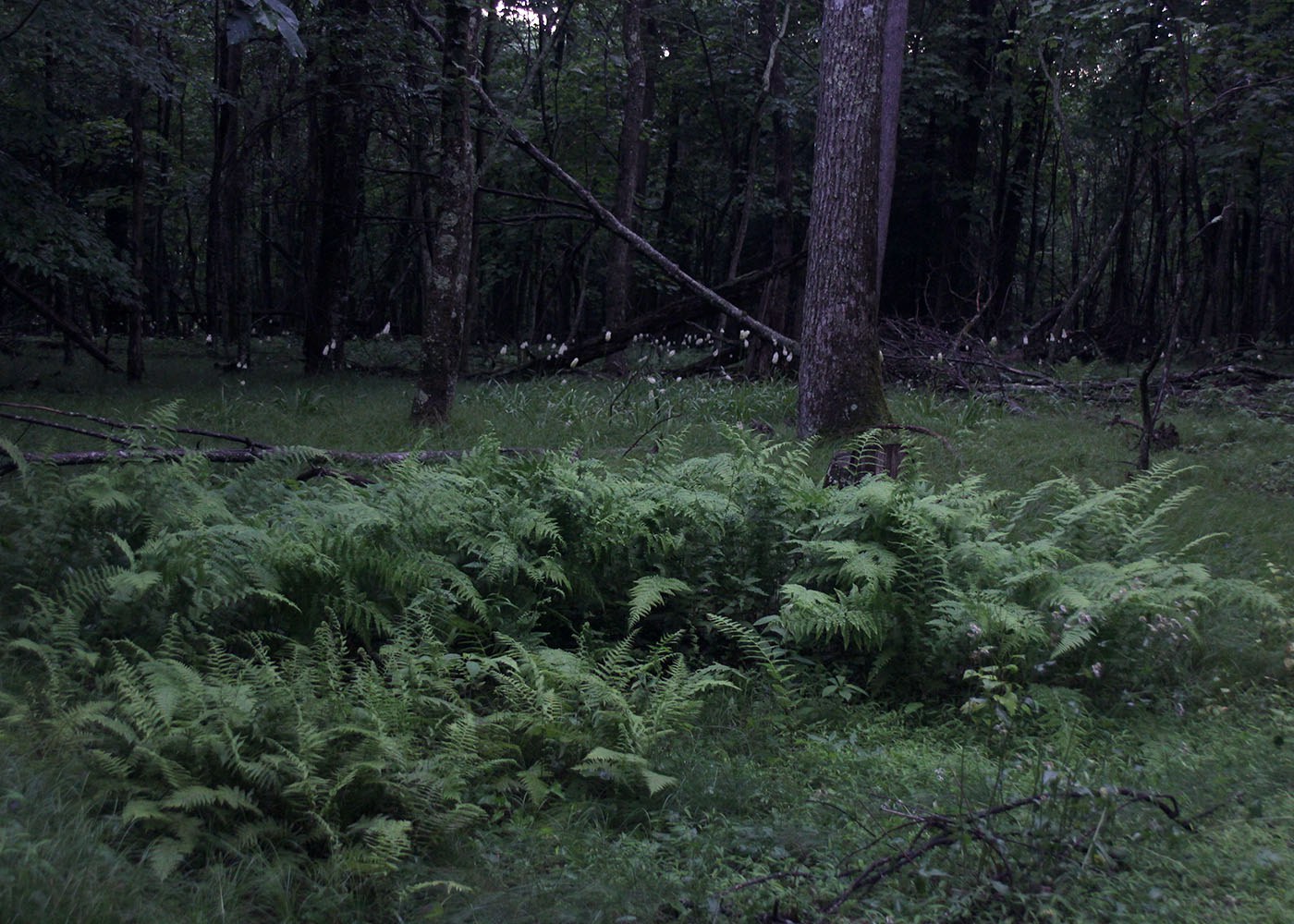
Essentially, Dr. Cawley and his team suggested that Mountain Lake was filling in not just from above the ground—but also below. And it was re-filling and emptying itself out on a relatively regular geologic schedule.
“We do not know of another lake anywhere in the world that follows this sort of filling-emptying dynamic,” says Dr. Cawley. His 1999 report backed up similar findings from 1975, in which Dr. Bruce C. Parker (Coincidentally, Dr. Cawley’s mentor at Mountain Lake) discovered an ancient yellow pine tree stump somehow rooted 10 meters in the lakebed.
Geologically, the reservoir is an aquatic anomaly. When full, Mountain Lake is over a half mile long. The unlikely body of water towers over much of the state of Virginia, at an altitude of nearly 4,000 feet. Plus, it seems to have an ingenious natural cleaning system unlike anywhere else on the planet.
This unique cycle heals the lake, prolonging its lifespan.
“What you would expect with a ‘regular’ lake,” says Dr. Cawley, explaining this special cycle, “Is that it’s sort of like a bowl. Every year, you wash in a little bit of sediment, a little bit of sediment, a little bit of sediment — Until, eventually, the lake fills in and that’s the lifespan of the lake.”
“Mountain Lake is interesting because during the periods of time that it empties, the sediment washes down into those holes at the bottom, to clean itself back out. The process allows the lake to grow larger and potentially deeper. It’s basically prolonging its life.”
The natural hydraulic locking system of the sediment, a process researchers still do not fully understand, also allows Mountain Lake to remain oligotrophic – a term geologists use to mean low nutrient quality, or algae levels in the water. The geologic disappearing act has historically given Mountain Lake very clear, blue waters – ideal for wayward travelers on their way through the American frontier, or film scouts looking for scenic Hollywood snapshots.
Q/A
Jessica Zielske is the former head of the Mountain Lake Conservancy, established in 1989 to preserve the resort’s natural beauty. She worked as a full-time naturalist on the land from 2009 to 2013, and witnessed the lake 'renovation' process first-hand. Here, she speaks to Silica about her experiences on the job.
Silica
How did you get involved with Mountain Lake?
Jessica Zielske
I started working there in 2009, so I pretty much only know Mountain Lake empty. First, they hired me on as a seasonal recreation manager and then I got the conservancy director job in 2011, where I kind of functioned as the naturalist for the company. I would do “engaging nature activities” for the guests. Walks down into the lakebed to talk about the geology of it, get up close and personal with what was going on in the lake. Or, depending on the season, we would do bird watching or wildflower walks, or walks in the woods. Also, any time researchers wanted to access the property, I would try to liaison that, asking the scientists where they were going, and what they were doing so that I could share that information with the guests.
So no-one knows where the water is going?
Well, there’s theory one, that it’s a partial earthen dam blocking up a stream and water is flowing subterraneanly through the stream and eventually popping up somewhere else. There’s also caves all over the place out there and within Salt Pond Mountain. So, there’s also some thought that the water is going down into the mountain and it’s not surfacing somewhere else. And then, as you know, the lake has gone low before. This isn’t the first time this has occurred at Mountain Lake. It’s just the first time since there was a lodge up there.
How has the Mountain Lake Hotel changed post-lake?
From the 1930s up until the 1980s, Mountain Lake was a pretty swanky place. For a time there, it was suit and tie, dress code, ballroom dancing kind of vibes. For a lot of years, locals weren’t necessarily invited up there.
But when the lake went low and business really dropped, that vibe kind of changed. They became way more local-friendly and we started seeing a lot of new types of people up there – the types of people it seems the hotel was trying to attract: Young, outdoorsy people, kids from the community. The change in advertising was really drastic post-2013. There’s a realisticness to it – you’re up in Giles County, you’re not off a major highway, and you’re kind of tucked away out here. It was like, let’s try to get everybody we can up here.
So did you guys get a lot of Dirty Dancing fans?
Oh my gosh, yes. It never ceased to amaze me how many people go up there for Dirty Dancing. We would see people from all over the country, who were like, “We went to New York, then D.C. and then we had to stop here.” When I first started working there, I was like, “Give me a break, it’s not even that good of a movie.” But I guess you’ve gotta make money somehow.
Were they bummed that the lake was gone?
Well, that was a whole other struggle. The lodge relied pretty heavily on Dirty Dancing for a while there. A lot of people would be like, no lake? Well, we’re going somewhere else, sorry. Even people who weren’t Dirty Dancing fans were upset, people who have been coming up since they were kids, and now they’re bringing up their families and grandkids. They’d say “Look, we came here for the lake. We would go spend all day fishing, swimming, paddle boarding and when the lake dropped, the place totally changed for me.”
You were working at Mountain Lake during the whole 'renovation' process to try to mitigate that loss. Can you tell us what happened?
First, a bunch of guys came in, two lead consultants from the Urban Land Institute. They interviewed a bunch of people, staff of the conservancy and the lodge, as well as locals, just trying to see what options were out there. Asking questions like “Are we gonna close this place down, or turn it into a boarding school or turn it into a park or keep doing what we’re doing?” Ultimately, they were like, we’re going to do some much-needed renovation into the company and we’re going to change the management of the whole place.
There was also a renovation project for the lake at that time. That happened in the winter of 2012 to 2013. You’ve probably heard the name Skip Watts, who was one of the lead geologists from Radford who had been involved with studies of the lake for years. He had a very meticulous and idealistic theory that we could block up some of these holes in the bottom of the lake.
What were these holes like?
Going down there and sinking up to your knees in mud, you could actually see these holes with the naked eye. They were inch to 12-inch size holes, with water pouring right down into them. It was four main depressions and the holes would be like five or six in each depression, kind of like these little pores. There were lots of them. It wasn’t just one big gaping hole that you could easily plug.
So how did they try to plug them up?
What was actually done in practice by the construction companies [hired by the hotel] was that they basically scraped the sides of this hill that used to be the side of the lakebed and tried to fill in these funnel-shaped depressions in the bottom. This was in the middle of winter, frigid conditions. Things were so freezing that the equipment was struggling to work. I thought they were just going to start sinking down into the mud, but they did it.
The next spring, water started filling slowly, like it always does. There was a lot of sediment runoff into the water, so it was very turbid. That was really shocking to people at first. But by June, it started to settle, and the water started to become more clear. It was quite a bit of time before researchers were even able to get a scope of what was going on down there.
Do you know of documented ecological effects of that fill-in process?
Well, there didn’t really seem to me that there was a whole lot of monitoring about the before and after. It kind of happened very quickly. The only sort of base data collected I know of is from the biological station, where classes would come to just do routine “This is how we sample a water system” kind of work.
Was the hotel beholden to any kind of conservation rules through that process?
It’s a really complex kind of relationship, at least it seemed like it. Took me a couple of years working there to really understand it. From what I know, the Mountain Lake Conservancy was founded in 1989, based on the verbiage in Mary Moody Northern’s will, basically saying that we needed to preserve the land for future generations to come and enjoy nature. So they created a 501c-3 nonprofit with that mission.
However, since the hotel is all privately owned, there aren’t a whole lot of strict regulations or rules. It’s more like, what can you do and get away with that the public will still allow you to call yourself a conservancy. That’s why interfering with the lake was definitely a controversial act. My thoughts on it throughout the process was that even though what they were doing wasn’t quite a do-nothing approach, which the most staunch conservationists would want, it at least wasn’t as drastic as it could have gone. Because there were a lot of other ideas on the table that didn’t fly.
Like what?
Everybody under the sun just said “Why don’t you just fill it with concrete?” But if you look at the geology of the lake, it’s not a stable bottom. Even if you were to pour anything on top of that, any time there was a shift in the underlying loose rock, more cracks are going to come up. Another idea was to put a pond liner on the bottom, which is also not feasible. Water is definitely going to find it’s way under that. There were also talks about trying to put a dam across the middle of the lake, trying to retain water on the front end, and then let the back do it’s own thing. But you’re definitely not returning the lake to full volume or aesthetic at that point. Also, it would be this super-expensive engineering feat. This isn’t the Hoover Dam we’re talking about. This is Mountain Lake over in Giles County.
Why were you let go in 2013?
With more decreases in funding, less profits to fund the staff positions, they decided the conservancy position was going to have to be seasonal or part-time. Basically, I was given the option of getting a huge demotion or just getting let go. But it kind of made sense. It isn’t just the conservancy that’s been affected. It’s the lodge property overall.
What do you think Mountain Lake Resort should do moving forward?
Basically, you’re not going to fix the lake, no matter what kind of sediments you try to move around the bottom or plug the holes. You’re just wasting your time. It’s a natural process and it’s going to do what it wants.
I’ve always been on the “Let’s turn it into a park!” team. Build some campsites or something. Other than that, I think if left undisturbed, it will come back to full. It could be five years, it could be 100 years or it could be never. But if we can just sit back and be patient and just observe and learn from it as much as we can, that would be best.
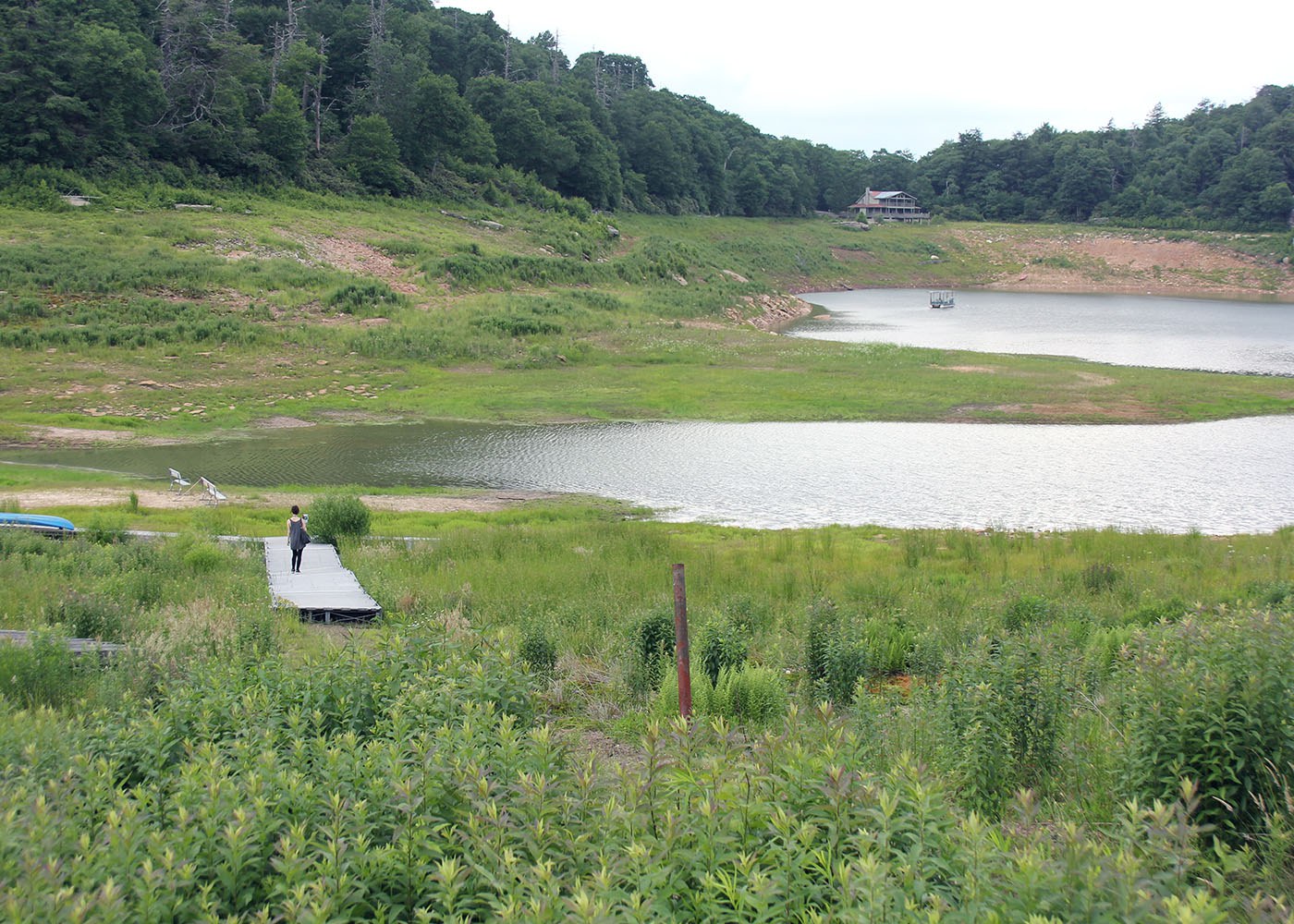
To me, the lake-turned-meadow already seems like a living fossil. We step out on to jurassic-looking moss, green on the bottom, prickly red on top, interwoven with a thick layer of dried, brown swatchy grass. It’s a crackly botanic layer over what is clearly a still-reliable source of subterranean water beneath our feet.
A few hundred feet out through the grass, we approach the lake. What once was a blue gem is now closer to a pond, it’s brownish-green hue suggesting it may soon transition to a more eutrophic state. We step around abandoned canoes and rotting rafts, some still tied to dilapidated docks that lead to nowhere. Every once in awhile, we are separated by massive fissures in the mud, leading to deep, dark underground unknowns.
Dozens of truck tracks lead into the lakebed and on top of the vast cliffs beside us, which we assume used to be the banks of Mountain Lake. Perhaps evidence of the fill-in mission waged against the lake’s deadly drains two years before?
As I approach what little water remains in the lake, I notice frogs and fish are still swimming around inside. I wonder how they could have ever survived that brown, empty mud pit from seven years ago. As I sink my toes into the silted shore, the water is warm and muddy at first. But as I wade in, there’s a distinct rush of cold water beneath me. Are the very springs that feed subterraneanly into Mountain Lake tickling my feet? The lake used to be 150 feet deep, and from the height of the banks surrounding me and the temperature of the water, it’s easy to believe.
Re-Making Mountain Lake
Four years after Mountain Lake drained down to dirt, the historic hotel was still searching for answers (See Q&A above with Betty Massey). As the dry years went on, business continued to decline. Family vacations found alternate traditions, and many of the devoted Dirty Dancing fans moved on to Lake Lure, a man-made body of water in North Carolina where scenes from the ‘80s romance were also filmed.
After a full year of deliberation, the Mountain Lake Hotel decided to try one last-ditch-effort to fight back against the mystery of Mountain Lake. They were going to try to fill in those holes – using an assortment of earthen materials, as a “natural” means to force water to stay put inside the lake’s basin.
The hotel decided to plug the drains.
The hydrologically heavy-handed decision was part of a $2.25 million renovation plan pitched for the hotel’s 2012-2013 season. The goal was to update both the inside accommodations of Mountain Lake Hotel as well as the property upon which it sat.
And that winter, the fill-in process began. The Mary Moody Northern Endowment, a Galveston, Texas-based foundation that finances the hotel, relied heavily on the research of Dr. Chester “Skip” Watts, a professor of environmental and engineering geology at Radford University throughout the renovation. The hotel’s plan was to fill in four major depressions discovered by Watts at the North end of the lake and they contracted researchers from the Urban Land Institute in Washington, DC to do it.
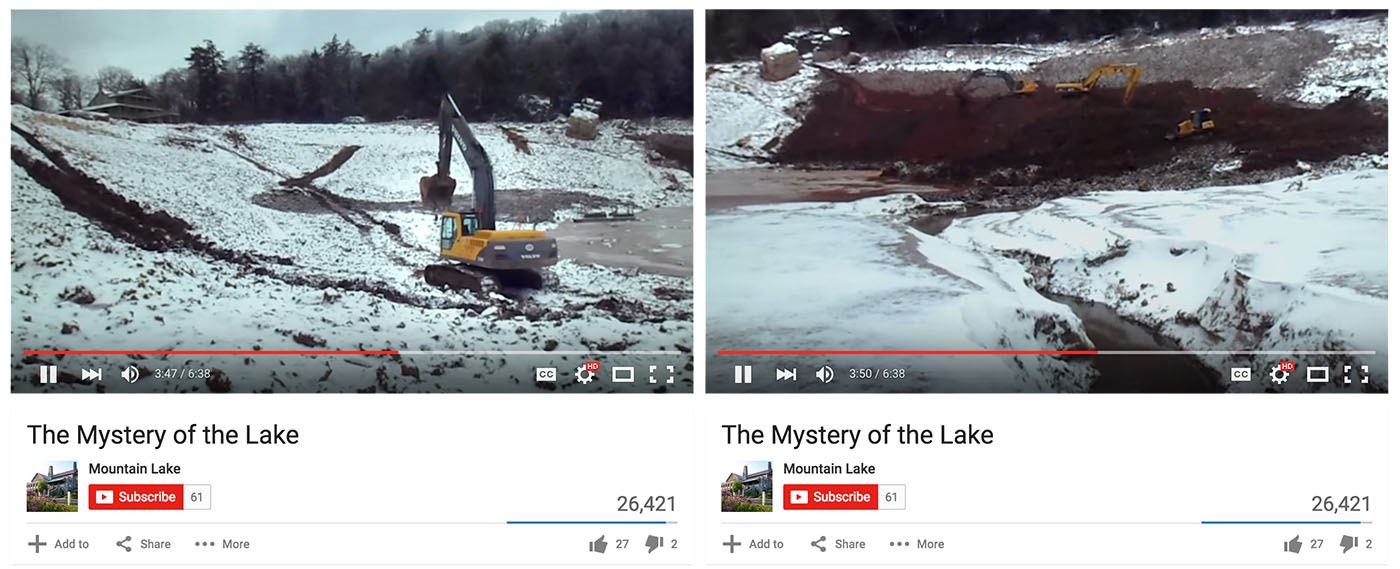
Construction crews hired on-site started filling with large chunks of rock, sourced from the region’s native soil, then weaned down to sediment, and finally to fine clay particles.
Mountain Lake Lodge actually made a video to explain the process, which is featured on its website to this day. “We are trying to make what mother nature would naturally do happen a little quicker,” said Betty Massey (see above) in an on-screen interview. Over the years, armchair internet geologists and ecologists have remained unconvinced by the methodology.
The lake ‘renovation’ masterminds were, in the words of Mountain Lake hotel’s manager, Heidi Stone, playing “whack-a-hole” in the empty lakebed, a process detailed by naturalist Jessica Zielske below. After the project was completed, Stone was quoted in the local papers saying, “We figure by next summer, it will be two-thirds full and we’ll have all our water sports and everything back next year.”
By 2013, Dr. Skip Watts, told the Roanoke Times he was “very very confident” the lake would rise to “full pond” within a year. When contacted by Silica to comment on the aftermath of the lake fill-in, Watts wrote:
“We were surprised to see the magnitude of the operation as it unfolded. When we requested plans or specific information so that we could comment on them, none were provided to us, and we remain unsure as to how certain decisions were made.”
“I will say that the hotel has been very careful about trying to keep the lake as natural as possible,” says Dr. Jon Cawley when asked about his thoughts on the 2012-2013 lake fill-in. However, he adds “I didn’t think that it was going to work and I also don’t think it was particularly wise.”
The idea was “Similar to paving over Old Faithful to make tennis courts,” Dr. Cawley continues, “Taking something that is a completely unique feature and trying to ‘fix’ it into a ‘normal’ lake – which it is not.”
Looking into the science, one finds a few major ‘holes’ in the methodology behind the ill-fated fill-in mission: First of all, Mountain Lake has a lot of drains, and its sedimentary bottom is constantly shifting. Geologists now suggest that no matter how many holes construction crews try to fill in the fissures, more would inevitably open up over time. In fact, as recently as August 2014, researchers discovered a new outlet in the bottom of Mountain Lake, post-‘renovation,’ that was estimated to be draining up to 1 million gallons of water a day.
Unlike Old Faithful, there are other geysers on the planet. There is no other lake that does what Mountain Lake does, period.Dr. Jon Cawley
And once again, there are theories that many of the springs and streams helping to fill up Mountain Lake are actually coming in from underground. Simply “paving” the lake, whether with “natural” sediment dumps or the thankfully veto-ed concrete idea, could actually inadvertently block those much-needed water sources.
Another methodological issue with the fill-in attempt, says Dr. Cawley, is that even after all these years, researchers still don’t fully understand how the hydraulic locking process works in the lakebed. The only thing they do know is it’s operating according to rules unlike nowhere else on the planet.
And messing with that delicate system any further could also potentially damage the geology and ecosystems of the lake over time.
“There is one big difference in that [Yellowstone] analogy though,” adds Dr. Cawley, a little bit later on in the interview. “Unlike Old Faithful, there are other geysers on the planet. There is no other lake that does what Mountain Lake does, period.”
It’s 2015 and Mountain Lake still has no lake.
Even those who originally lauded the hotel’s “whack-a-hole” operation have been forced to change their hubristic approach toward the mysterious body of water.
For now, the Mary Moody Northern Endowment says it will no longer invest any more cash in throwing materials – natural or artificial – down into the lake’s perplexing holes. And today, it’s clear that Mountain Lake Lodge’s latest marketing approach has become decidedly less water-centric.
As for research on the geologic anomaly: “We’ve focused so long on where the water is going, we’ve not been paying attention to where the water comes from,” said Dr. Skip Watts during an interview with local papers in 2014. That’s where the final Mountain Lake debate comes into play: How did that crystalline body of water get so up high in the Virginia mountains in the first place?
Until very recently, the prevailing theory relied on a landslide. The story goes, that thousands of years ago, falling earth created a partial natural dam that stopped up one end of a stream, flooded the surrounding mountaintop meadow and eventually, over the years, created the massive lake basin we see today. However, Dr. Jon Cawley, who worked as a professional geologic consultant in southern Pennsylvania for years before he had even heard of Mountain Lake, challenges that theory.
“I know landslide situations, and they don’t produce a lake like that,” says Dr. Cawley. As an alternative, the geologist points to several tectonic formations that fit like puzzle pieces beneath the water.
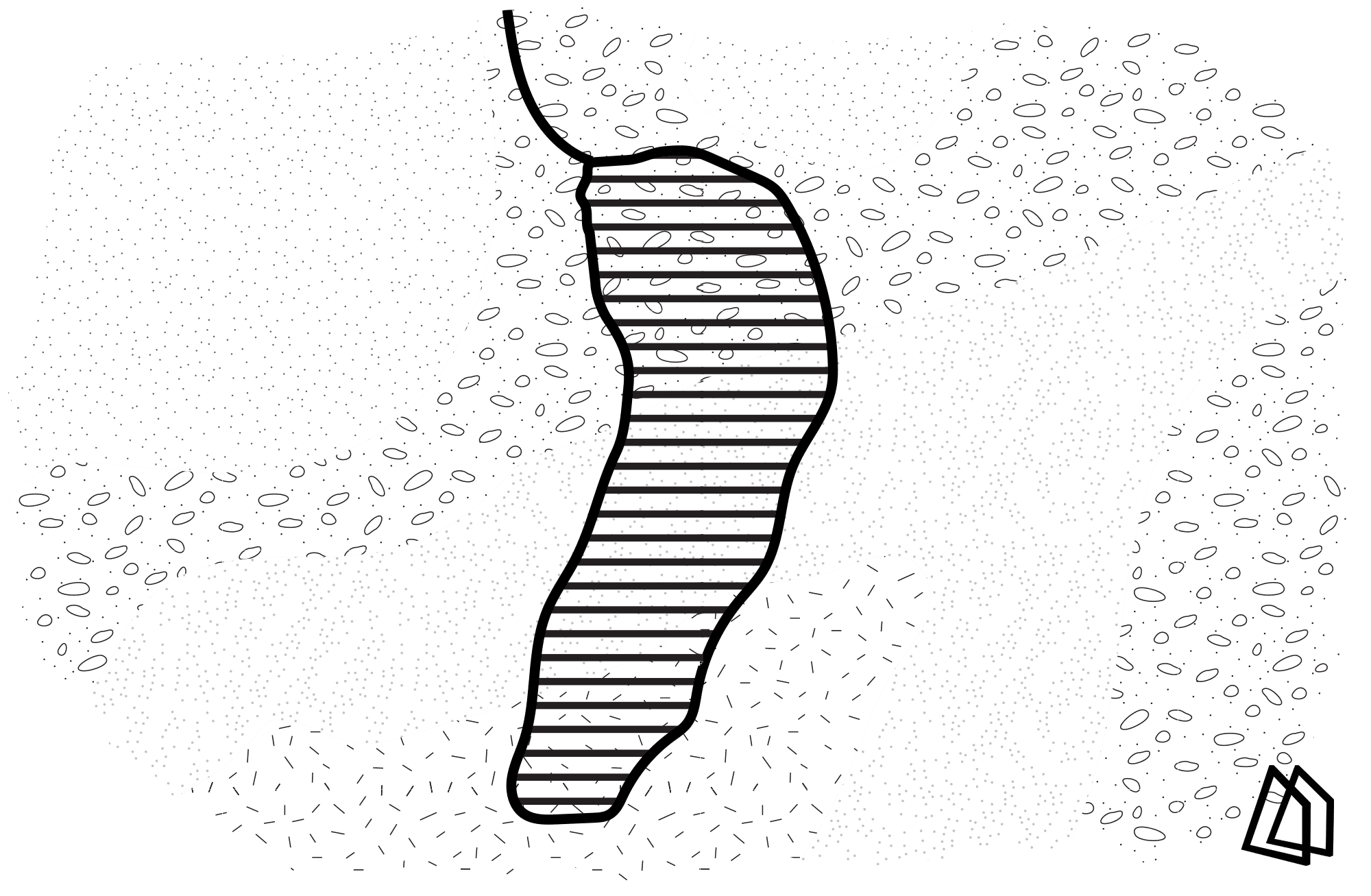
According to topographic maps of the region, Mountain Lake overlays three distinct geologies: The shallow section of the lake basin, located near the hotel, has a bottom made up of Martinsburg shale. The deepest section, towards the North end of the body of water is underlaid by Clinch sandstone. Then, a transitional section in the middle of the lake, mainly Juniata sandstone, acts as a buffer zone between the two.
Each portion operates by entirely different geologic rules, and each rock, interestingly enough, overlays what Dr. Cawley calls a mysterious “linear formation” that jaggedly cuts across the bottom of the lakebed. That linear formation, Dr. Cawley explains – which is similar to a fault but not necessarily active tectonically – is precisely where the major holes in the bottom of Mountain Lake are located. The crack also lines up directly with Pond Drain, the major stream that pours water out of the lake.
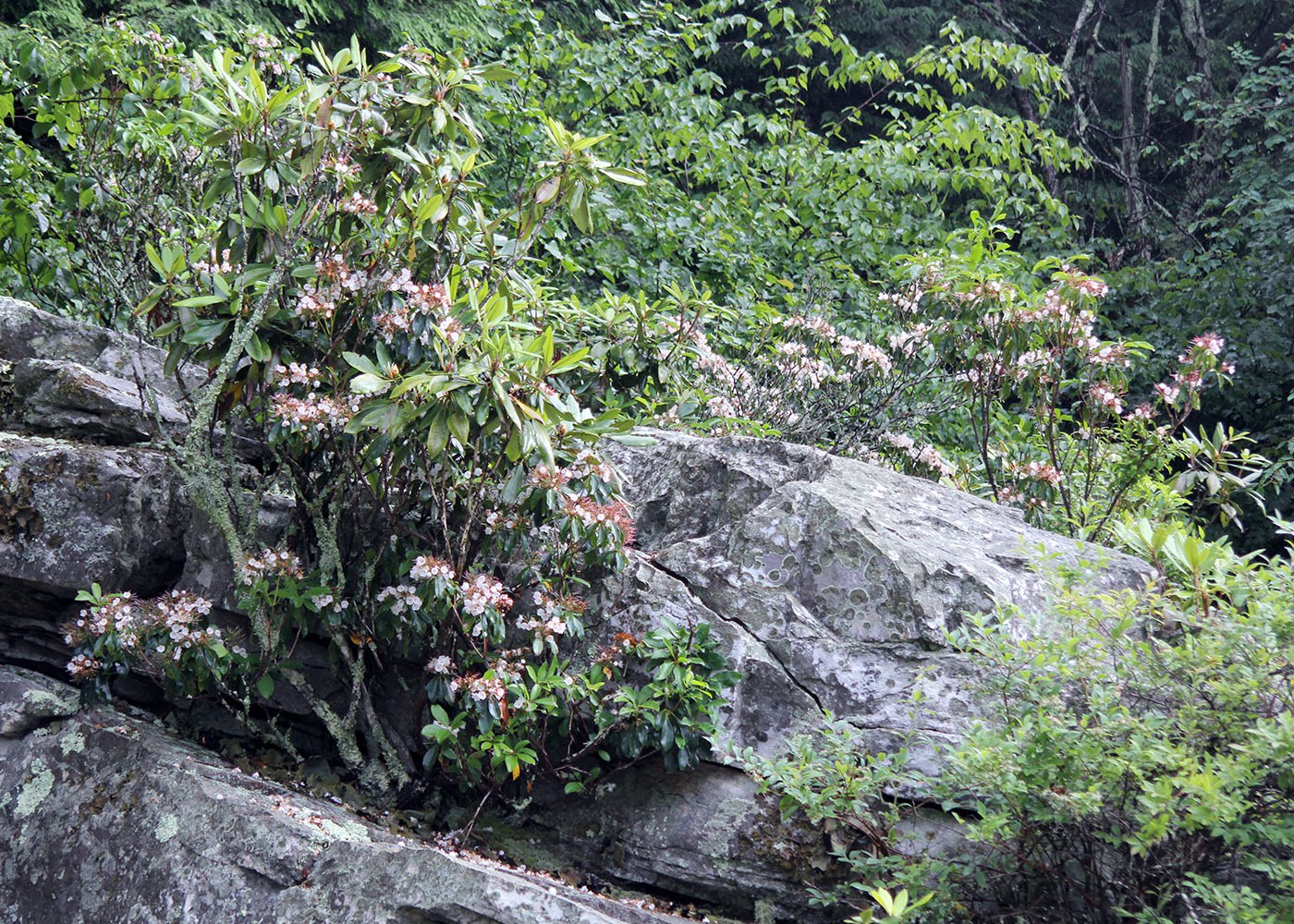
What’s more, the feature runs directly perpendicular to the Saltville Fault, an active seismic crack which stretches from Virginia all the way to Alabama, which has produced earthquakes in the mountainous region as recently as 2011. Dr. Cawley now thinks that “linear feature” may actually be an adjustment fault, which could potentially have drastic ramifications for the lake over time.
“The people at Radford are still working on the assumption of a landslide,” Dr. Cawley says, a hint of irony in his voice.
But after explaining three more highly technical reasons why it could not possibly be a landslide, the scientist stops himself. “I am going to ask you to be slightly circumspect on that. It’s going to be in my upcoming argument,” he warns, referencing an upcoming paper he is working on with Smithsonian scientists to further prove the theory.
I assure Dr. Cawley I won’t scoop his story.
Q/A
John and Courtney Richter are a married couple, former employees of Mountain Lake Lodge's 2013-2014 season. John worked at the resort’s recreation department, helping guests wrangle zip-lines in the new ropes course. Courtney waitressed at the hotel’s restaurant. Here, they speak to Silica about their take on how the hotel is faring, post-lake.
Silica
Do people still go into the water up at Mountain Lake?
Courtney Richter
People kayak sometimes, but that was last winter.
John Richter
The lake is still very low. It’s at like, 12 percent, maybe lower. The only boat I’ve seen out there this year is the geological research survey’s pontoon boat that they keep there all the time. Otherwise, there’s not much going on with the water.
Do people still enjoy going to the hotel at its current state?
J: Definitely. Last summer, the recreation department would do scheduled hikes focused on either the birds or plants or the geology of the lake. All of the people who were actually interested in science were not bummed out that the lake was gone, or at least not completely bummed out. They were kind of like, “Oh yeah, this is still cool.”
How so?
J: I’m really into the biology of it, so like, looking at all the different microclimates in and around the lake. If it’s been damp, you’ll see some really cool mushrooms and slime molds. And then when you get down into the lakebed itself, it’s almost a Jurassic Park type of thing. Some of the rhododendrons there are like a hundred years old. Then up on the mountain, there are some beautiful overlooks to hike to. It’s also really close to the Appalachian trail.
Standing in the lake, you can see all of these dead Hemlocks. Do you know anything about woolly adelgids? They are this tiny aphid that destroys Hemlock trees. It’s been happening all across the Appalachians. Anyway, when you’re in the middle of the basin you see sort of, skeletons, all around you. They’re like the tallest trees in the forest and they’re all dead.
There had to be some people who were upset about the “no lake” Mountain Lake part, though, right?
C: Yeah. People who booked online would come up and be like, “Hey, where’s the lake?” And we were just like, “I don’t know either. It does this sometimes, I’m told. But I’ve never seen it either.” We read a lot of nasty TripAdvisor reviews as well. There were also a lot of German people, for some reason who came up there to see the lake. Like, they were one of our biggest guest populations.
J: You know, I was talking with some tourists from Germany last year, and they were like, “Yah, On any given day in our country you can turn on the TV at some point and you’ll see Dirty Dancing airing somewhere on cable.” A lot of those international tourists would come up expecting this huge event for Dirty Dancing weekends, and then it was just like, me hosting Dirty Dancing-themed Bingo bleary-eyed in the morning. Also, now there’s not even like, a small pond where they can practice that lift.
Do you think the hotel is going for more of the traditional Mountain Lake Resort atmosphere or a rustic, eco-tourism type operation?
J: I think the management tries to flip it one way or the other, which, if you do it perfectly, works great and 100 percent of people are pleased. But you always have to worry about flipping it at the wrong time. I feel like people who want the swanky vibe get more of this rustic thing, and then the rustic people get this kind of snooty atmosphere. One of the biggest complaints we heard from guests was like, “Well, we just wanted to get a hamburger.”
C: Totally. When I was working up at the restaurant, food was anywhere from like $17 to $32, served to you in this jazz club-type scene, you know? In my time at the restaurant, we also went through 5 or 6 managers. A lot of them were fired, but a lot of them left on their own, too. I think they just got worn out.
J: Wasn’t there like car keyings and meth people and a guy named Kermit that bounty hunters came for at the hotel?
C: It’s a lot of local drama. “Did you know his wife was in jail?” kind of stuff. A lot of employees had worked up there every season, way longer than the rest of the management, so they sort of had the feeling that they ran the place. There was no real allegiance to the hotel, just the old customers.
J: Speaking of which, the last chef to work there was really into sustainable agriculture. He had an idea to turn the lakebed into a small farm while the lake was empty and turn the place into a farm-to-table kind of thing. But I don’t think Heidi, the General Manager, ever wanted to ever admit that the lake wasn’t coming back tomorrow.
How do you think the hotel is doing, business-wise?
J: You’ll just see them really reaching and hustling up there. They recently filmed a “Looking for Sasquatch” TV special up there, and also this Dirty Dancing-themed reality show a couple of years back, too. Of course there was the new ropes course I worked at last summer. They also just recently bought these super-weird beach balls that go from your knees to the top of your head, that you can just wear and run around into stuff without getting hurt.
It kind of hurts when I drive past the hotel every day to get to my job at the biostation, because I’m like, there’s so much cool stuff up here, you don’t have to buy weird toys to attract people. The land should sell itself, regardless of the lake being empty.
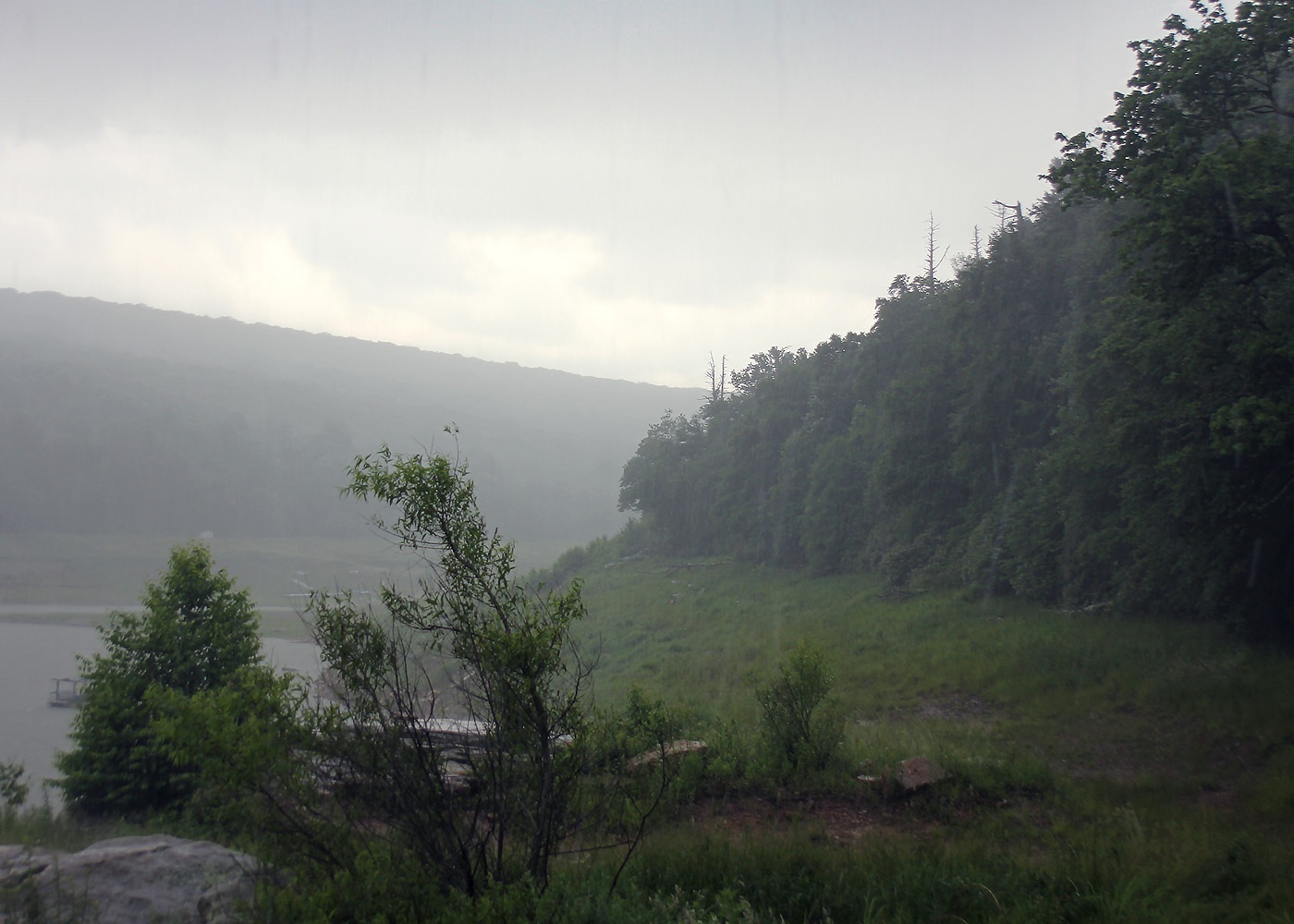
We hear thunder. We’ve actually been hearing it all day, mixed in with the sound of heavy machinery from rock mining(?) on the mountains above us – but it’s gotten louder, more persistent, as the afternoon wears on.
We’re headed towards an abandoned cabin at the North end of Mountain Lake, which used to be called Newport Cottage, the former crown jewel of the resort. It is now condemned, surrounded by a fence. The deck out front of the massive cabin cantilevers purposelessly over thin air, hanging in suspense over what used to be water.
The storm is directly above us now. With a sudden clap of thunder, we begin to hear hard knocks. A torrent of marble-sized hail and cold rain pelts our backs, as our shoes sink and slide in the mud below our feet. The hail hurts. We run for cover in the condemned cabin, across a crackling wood deck, and pant under the roof’s protective eaves.
Hail pops off the roof at 45 degree angles. We watch the icy spheres sink into the lake. As our friend John Richter told us prior to heading up, “Weather moves fast up on the mountain” and the storm is over in 20 minutes, as patches of blue sky suddenly streak through the clouds.
By now, Mountain Lake has turned blood red. It’s clouded with the color of the clay soil above it that was scraped off the North bank into the lakebed two years ago. The land is still covered in truck tracks.
Water Makes Warning
“People would love me to say the lake could be back in five to twenty years, but there is a big chance it might take 50 to 80, too,” answers Dr. Cawley, when asked to make rough geological predictions about the future of Mountain Lake. However, there is one factor of the mysterious aquatic equation scientists cannot account for in their models quite yet: Human-driven climate change.
According to surveys from the U.S. Global Change Research Program, the entire Southern Appalachian mountain range is soaking up one-third less precipitation than it did back in the 1970’s. Unseasonably hot weather has caused an influx of forest fires in the historically damp wilderness and for the first time ever, sections of the Appalachian Trail have had to be shut down to hikers due to heat-stroke risk.
The lake draining could be a foreboding sign of times to come.
Dr. Cawley says the ongoing drought could even affect Mountain Lake’s ability to re-fill once this current stage of its cycle is over. In fact, the lake draining could potentially be a sign of bad times to come for the region’s surrounding ecosystem.
“Mountain Lake is really the canary in the coal mine for climate issues in the Southern Appalachian biodiversity bump,” says Dr. Cawley, referring to the fact that the ancient mountain range upon which it sits contains some of the highest numbers of individual plant and animal species per-square-mile than any other place in the world.
Over the years, the complex oligotrophic nature of Mountain Lake has served as a litmus test for the ecological health of the region. Ecologists say the water in the lake basin itself has been historically less polluted than the rain falling into it. Until now, the purity of its water has remained a reliable constant.
But today, nestled between ridges, up high in Virginia’s Blue Ridge Mountains, the lake lies in wait — its waters rippling in mysterious depths and reaches. The lake vanishes, obscuring the fate of earth’s uncertain future.
Casey is a writer and strategist living in New York. In 2016, she co-founded Silica Magazine and is now our editor-in-chief. When not slinging lines in the agency world, she writes for Engadget, SYFY, VICE, Campaign, Bustle, POZ, and others–– examining unexpected waypoints between science, tech, and creative expression.
Q&As have been edited for clarity and conciseness. Topographic and bathymetric visualization is approximate. Lake water level percentages based on Bruce C Parker's 2003 study 'Review of Research Studies at Mountain Lake, Virginia.' Clip: Dirty Dancing, (1987). Special thanks to Aaron Grigsby and 'The Rug Boys.' In loving memory of Patrick Swayze.